‘Thailand Giant’ is the king of all plant monsters

Photo/Illustration: Antonio Reis
Colocasia gigantea ‘Thailand Giant’
Usda hardiness zones: 8 to 10
Size: Up to 9 feet tall and 12 feet wide
Conditions: Full sun; rich, moist soil
‘Thailand Giant’ is, undoubtedly, the plant with the largest foliage in the aroid (Araceae) family. It started appearing in gardens across the country within the last decade. Leaves emerge in mid- to late spring, reaching more than 6 feet long and 3 feet wide in one season under optimal conditions. I’ve been digging out and overwintering a plant for three years now, but this past spring, I found a bud that had been left behind and survived winter; it grew a whopping 8 feet tall and wide in its first year in my Zone 7 garden on the south side of a brick wall that reflects heat and winter sun. Children and silly adults love to compare their ears to those of ‘Thailand Giant’.
‘Black Magic’ is a dark wonder
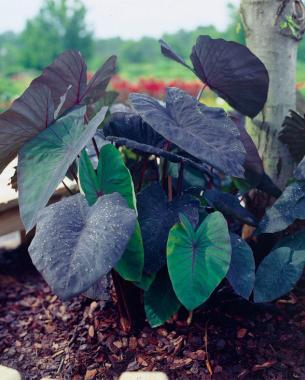
Colocasia esculenta ‘Black Magic’
Zones: 8 to 11
Size: 3 to 6 feet tall and wide
Conditions: Partial shade; moist to wet soil
‘Black Magic’ makes a perfect partner for chartreuse or silver plants. It also makes a wild statement as a bog plant. Its black leaves grow to 2 feet long on 3- to 6-foot-tall stems. ‘Black Magic’ is a well-mannered clumper. A lack of humus impairs this plant’s ability to flourish, so lay it on and let ‘Black Magic’ put a spell on you.
Like its namesake, ‘Mojito’ is the life of the party

Photo/Illustration: Antonio Reis
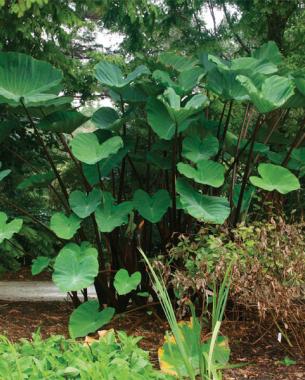
Photo/Illustration: Michelle Gervais
Colocasia esculenta ‘Mojito’
Zones: 8 to 10
Size: Up to 4 feet tall and wide
Conditions: Full to partial sun; rich, average to moist soil
You must grow this plant—if only to be able to tell everyone that you have a mojito waiting for them in the garden. Its green leaves are set off by dark flecks and purple stems. The speckled patterns, splotches, and streaks vary from leaf to leaf, so no two ever look quite the same. ‘Mojito’ makes a thrilling addition to perennial beds, where its exotic form and color will add more surprise and interest than any other shrub or perennial you might have considered putting in its place.
‘Coffee Cups’ performs a wonderful little rain dance
Colocasia ‘Coffee Cups’
Zones: 8 to 10
Size: 6 feet tall and 4 feet wide
Conditions: Full sun to partial shade; average to moist soil
‘Coffee Cups’ is one of the most entertaining elephant’s ears on the market. Its cupped leaves face upward, so they collect falling water and gracefully tip over to release it when full. Can you imagine anything more entertaining to watch from indoors on a rainy day? The plant’s foliage is dark green with purple veins on top of purple stems—a stunning combination. ‘Coffee Cups’ makes masterpieces of pots but also looks fabulous rising from the back of a perennial border. This plant is sometimes mistakenly sold as ‘Tea Cups’.
How to prepare elephant’s ears for a winter siesta
If elephant’s ears aren’t hardy in your area, you can overwinter them in two ways, depending on your hardiness zone:
Zones 6 and colder: The plants need to come indoors.
• Cut stems to 6 inches tall after the first frost.
• Place the tubers in a bulb crate, plastic pot, or grocery bag, and lightly cover the tubers with a mix of peat and soil.
• Dampen the mixture with water, and set the container in a cool, dark place to make sure the plant stays dormant. Keep the tubers moist but not wet; wet roots will rot.
Zones 7 and Warmer: The plants can stay outside but will need a blanket of leaves and grass.
• Let the frost desiccate the elephant’s ear’s stems naturally. Cutting leads to rot.
• Mow over fallen tree leaves and lawn grass to chop them up.
• Wrap chicken wire around the plant, and reinforce it with rebar posts stuck into the ground. The wire should be 16 inches from the central stems and tall enough to hold a 6-inch depth of leaves around the base of the plant.
• Fill the cage with the prepared leaf-and-grass mixture, and uncover the plants after the last spring frost.
Perfectly shaded ‘Illustris’ adds pattern and variety
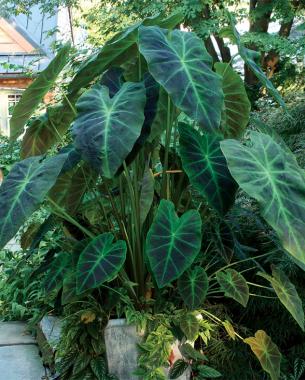
Photo/Illustration: Kerry Moore
Illustrious? No: ‘Illustris’. But its many-shaded leaves have earned the plant an illustrious reputation in gardens everywhere. Also known as imperial taro, ‘Illustris’ runs the gamut of color effects. The purple color oftentimes fades away as the leaves age, but the plant somehow hangs onto its emerald green veins, which look like plant-embedded fossils. Expect a smaller-size plant if it is grown in dry or clay soils. ‘Illustris’ will not survive outdoors in regions colder than Zone 8, even if it is put to bed with leaves as insulation. The tubers must be dried and stored indoors.
Colocasia esculenta ‘Illustris’
Zones: 8 to 11
Size: 3 to 6 feet tall and wide
Conditions: Partial to full shade; moist to wet soil
There’s nothing quite so bright as ‘Lime Zinger’
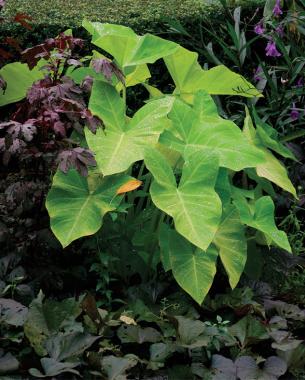
Photo/Illustration: Michelle Gervais
Xanthosoma aurea ‘Lime Zinger’
Zones: 9 to 11
Size: 4 to 5 feet tall and 3 feet wide
Conditions: Partial shade; moist soil
‘Lime Zinger’ makes a great tropical statement and brightens any dark corner. Use it in combination with black, purple, or brown plants for a thrilling picture. If grown in too much sun without ample moisture, the plant’s leaves turn brown; conversely, ‘Lime Zinger’ doesn’t fare well in standing water. Moist soil is just what this elephant’s ear wants. ‘Lime Zinger’ belongs to the genus Xanthosoma, which is discernible by its arrow-shaped leaves.
‘Diamond Head’ adds waterside drama
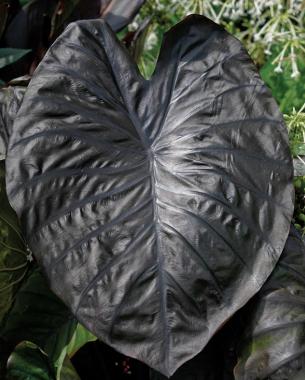
Photo/Illustration: Joshua McCullough
Colocasia esculenta ‘Diamond Head’
Zones: 8 to 10
Size: 4 to 6 feet tall and 2 to 4 feet wide
Conditions: Full sun; moist, rich soil
When breeder John Cho combined a black Colocasia and a glossy Colocasia, he created something shiny and new: ‘Diamond Head’. It is named after the volcanic cone on the Hawaiian island of Oahu, which makes sense because both the cone and plant are black and lustrous. The plant’s leaves reach at least 16 inches long and 1 foot wide. ‘Diamond Head’ performs best along the edge of a pond or submerged in a water feature. If left in dry conditions, its leaf edges burn. In shade, it loses luster and appears dark green instead of purple or black. That purple-black color is what makes ‘Diamond Head’ so special, so if the light conditions in your garden don’t suit it, you might want to choose another cultivar.
‘Stingray’ dares to break the norm
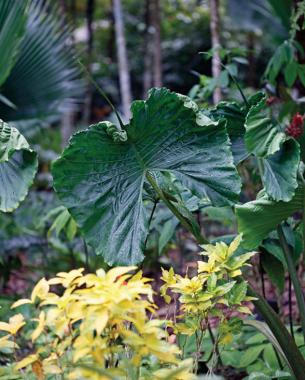
Photo/Illustration: Joshua McCullough
Alocasia ‘Stingray’
Zones: 9 to 11
Size: Up to 5 feet tall and 3 feet wide
Conditions: Full sun to partial shade; moist yet well-drained soil
‘Stingray’ is the elephant’s ear to acquire if you’re after one-of-a-kind foliage. Like all Alocasia, the leaves of ‘Stingray’ point upward and outward, which show off its ribbed, leathery, emerald green surface. The whiptail conclusion of its inward-curving edges earns ‘Stingray’ its name as this shape resembles the marine animal. ‘Stingray’ unfurls new leaves quickly as long as it’s given ample moisture and sun. I’ve been pleasantly surprised to find a new leaf shooting up from a specimen after spending a weekend away from home. If you plant ‘Stingray’, be prepared to field inquiries from every visitor to your garden, regarding what the heck that plant could possibly be.
‘Calidora’ is green, grand, and glossy
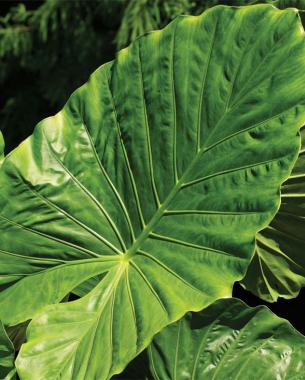
Photo/Illustration: Bill Johnson
Alocasia ‘Calidora’
Zones: 9 to 11
Size: 7 feet tall and wide
Conditions: Full sun to partial shade; moist, rich soil
‘Calidora’ produces big ribbed foliage that looks like it could have fanned Cleopatra once upon a time. Its upright, arrow-shaped leaves sit on larger-than-life petioles, and can grow up to 6 feet long and 3 feet wide. In full sun, you can expect a V-shaped clump, 2 feet wide at its base and 6 feet wide on top. ‘Calidora’ looks great in a pot or looming over a flower bed.
‘Black Beauty’ holds its leaves high, even as temperatures rise
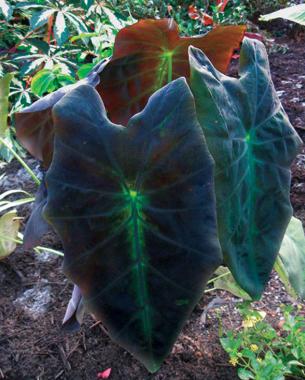
Photo/Illustration: Adrienne Roethling
Colocasia esculenta ‘Black Beauty’
Zones: 8 to 10
Size: 3 to 4 feet tall and wide
Conditions: Full sun to partial shade; moist, rich soil
‘Black Beauty’ is my new favorite elephant’s ear. A mutation of ‘Illustris’, ‘Black Beauty’ is grown for its 2-foot-long, 1-foot-wide, dark purple leaves with green stems and green veins. Once established in my garden, this plant held onto its leaves through the heat and drought of summer in full sun, which is unusual for the dark-foliage forms of elephant’s ears: They tend to look less than lovely when temperatures rise above 90°F.
Fine Gardening Recommended Products

Gardena 3103 Combisystem 12-Inch To 20-Inch Adjustable Metal Fan Rake Head
Fine Gardening receives a commission for items purchased through links on this site, including Amazon Associates and other affiliate advertising programs.
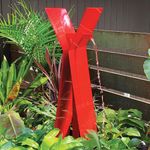
X3 Stainless Steel Midi-Mod Fountain
Fine Gardening receives a commission for items purchased through links on this site, including Amazon Associates and other affiliate advertising programs.
-9.5" w by 9.5" d
-Powdercoat over stainless steal

Ho-Mi Digger - Korean Triangle Blade
Fine Gardening receives a commission for items purchased through links on this site, including Amazon Associates and other affiliate advertising programs.



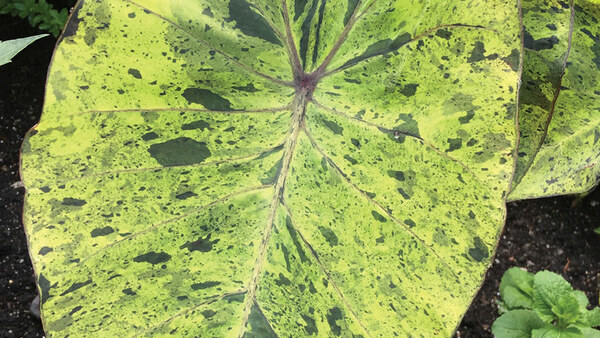
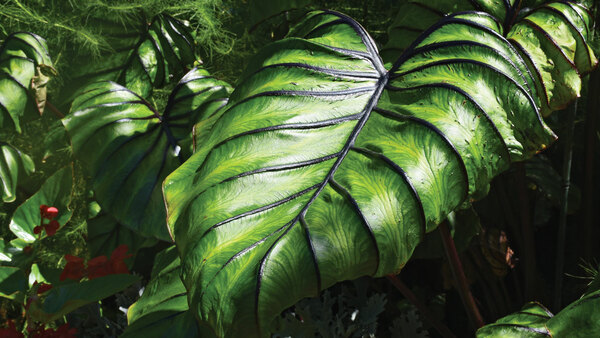

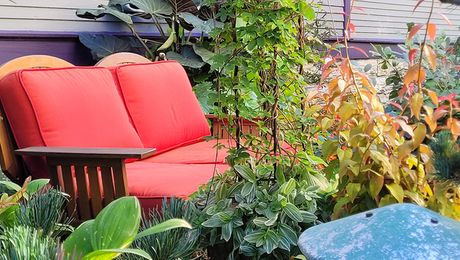











Comments
Wow! These are gorgeous plants that someday I will try to grow. I have always been too busy to mess with bringing them indoors. We live in zone6 or 7 and I don't think it would make it through the winters here. I love their foliage, their jungle appearance. Thanks for this article.
Log in or create an account to post a comment.
Sign up Log in